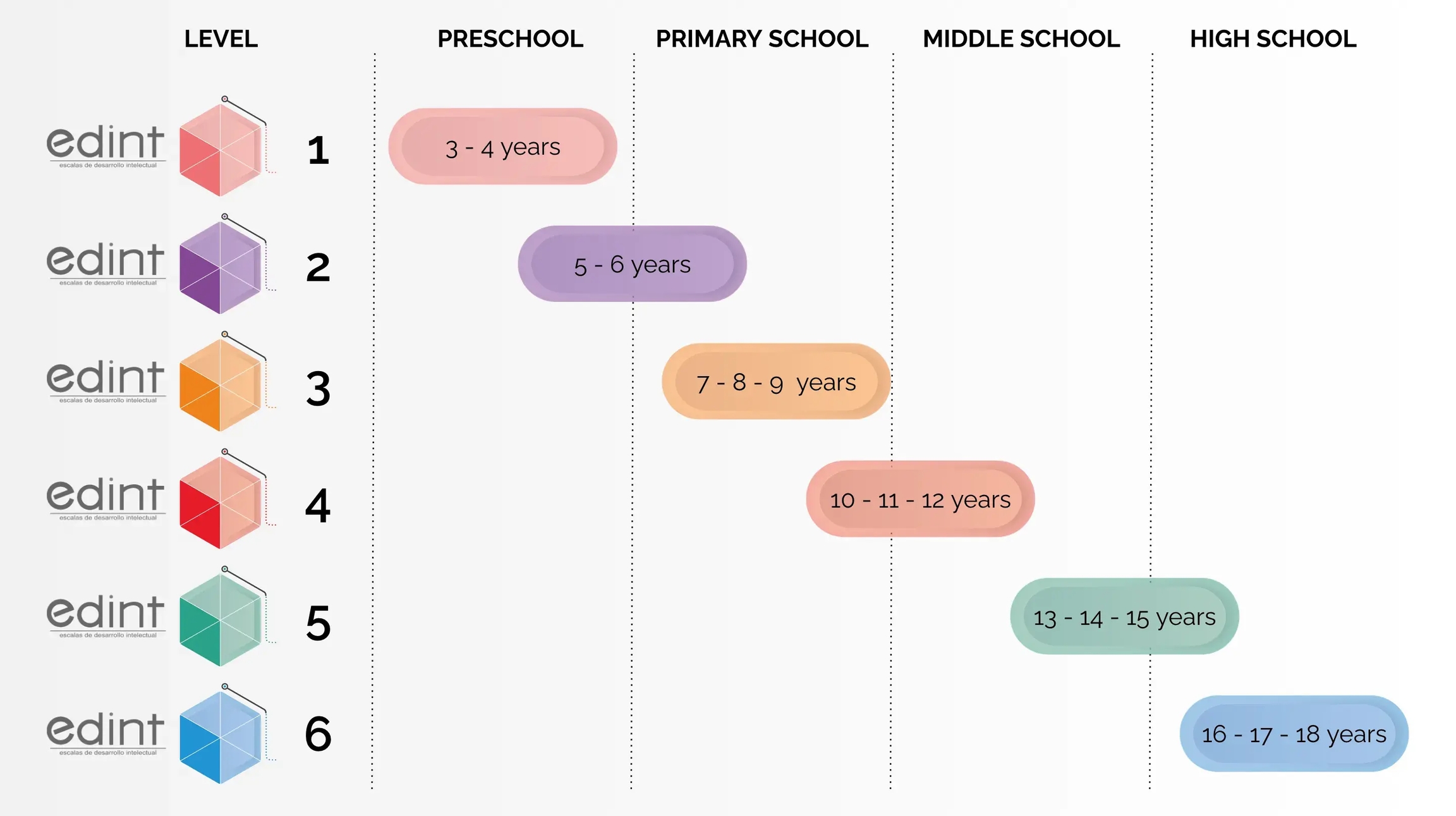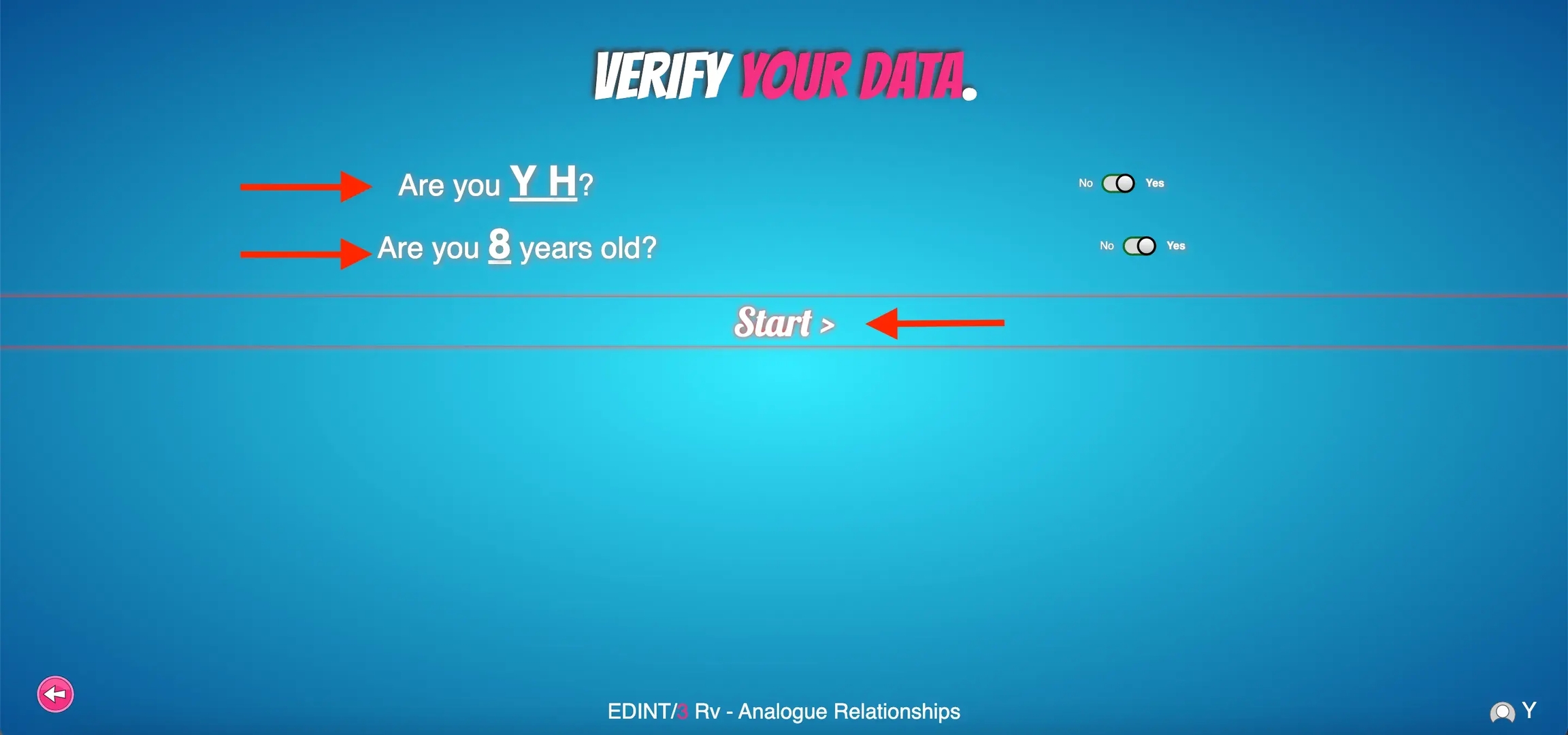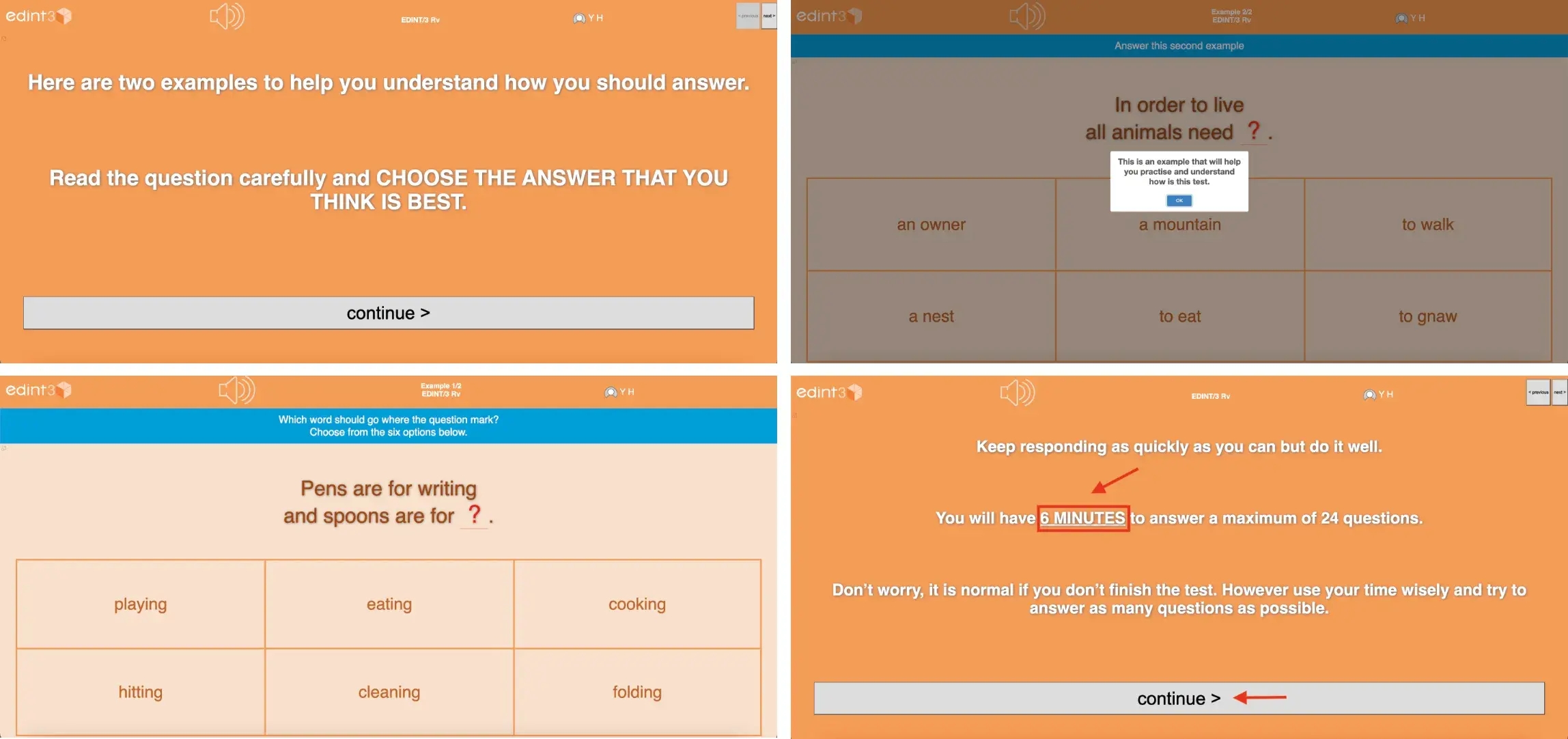➡️EDINT: Application manual
Introduction:
EDINT tests (Escalas de Desarrollo Intelectual in Spanish) help to detect students with high abilities, measuring mental abilities that reflect the structure of intelligence.
The test can be applied in two ways:
1. From the school (face-to-face).
2. From home (remote). This option is recommended from 4th grade onwards in the case of students who show high abilities. For this option, the guidance department must make a prior selection of students. Refer to the corresponding manual to know the specifications of each modality in order to carry out the application successfully:
If you are applying the test for the first time, please read the following instructions carefully.
General considerations:
Objective: To measure a set of mental abilities that reflect the structure of intelligence and is organized as follows: Benefits:
Benefits:
To know the intelligence quotient (IQ) of each student.
To obtain objective information at a cognitive level about each student in the school. Efficiently, detect students who may need a more specific intervention.
Identify students with high abilities.
Target Audience: The test is organized in 6 levels, according to the age of the students. It can be applied to students from 3 years and 6 months to adults.

Time: 30-50 min. (depending on the level)
Specific materials and resources:
1. Have headset headphones only for EDINT levels 1, 2 and 3 (from Nursery / Kindergarten through 3rd grade). In the case of the youngest children, audio can be used directly if the application is individual.
2. The application must be carried out according to the application ratio:
NIVEL
RATIO
EDINT 1
maximum 3 students per supervisor
EDINT 2
maximum 8 students per supervisor
EDINT 3
maximum 12 students per supervisor
EDINT 4 - EDINT 6
maximum 20 students per supervisor
3. It is recommended to guide and explain only up to the resolution of the examples of the first challenge, so that the students understand the dynamics of the test and know how the platform works. For this purpose, the test can be projected on a large screen using the demo user a.k.a. "Pepe prueba". As soon as they start the first challenge, they should continue and finish the test individually.
4. It is not allowed to use any separate sheet, neither in the numerical tests nor in any other to operate or to make any diagram or drawing. The operations must always be done mentally.
Specific considerations for EDINT levels 1 and 2 (in some cases EDINT 3)
1. It is important that the applicator should be perceptive to the pace of the younger students. If it is observed that they show signs of fatigue, it is better to conclude the challenge in progress and suspend the test to continue the next day (preferably at the same time). The results of the completed challenges will be saved.
2. Students should be supported by entering their data in the corresponding screens, as mentioned in step 4 below. EDINT 1 students can even be helped with mouse handling.
3. There is no time limit for taking the test, although there is a time limit for answering each question. Students are given 30 seconds to answer each question. If the student does not answer, he/she is automatically directed to the next item.
4. If headphones or audio are not available, the applicator must read the questions up to two times. If the student indicates that he/she did not understand the first time, the applicator must read the questions up to two times. In this case, the application must be individual.
5. By clicking on the speaker button, the questions can be repeated a second time.
6. It is necessary to explain the examples of each challenge, making sure that the instructions are clear, before the students continue.
Specific considerations on the application
1. It is carried out in a single session (with the exception of EDINT 1, 2 and 3).
2.It can be applied to the whole group at the same time.
3. Students in Level 1, 2 and 3 should be helped to enter the temporary key.
4. From level 4 onwards, students should record the key by themselves with the appropriate guidance.
5. Once the temporary key has been recorded and after having selected themselves from the list of names, they should indicate their date of birth and gender in order to answer the corresponding level of the test. In case of difficulties, students can be supported in entering their data. 
6. Then, you must select the first test "Verbal Analogies" and click on "next". You will be taken back to this same screen once you have completed the first test and you should select the next one.
Afterwards, the following screen will appear. Students should listen to the question and provide the correct answer, this will corroborate the correct functioning of the audio.

7. After this, all students must corroborate their data and wait to listen to the instructions of the applicator before clicking on "start".

8. the following explanation should be given to the students prior to the test:
a. You will perform some exercises that will allow the school to know different aspects. (We can say, in general lines, that intellectual skills are the tools they use to acquire knowledge).
b. It is not an academic exam, as it will not affect the grades.
c. You will take a series of quizzes. Each quiz has a maximum completion time. You will not be able to move on to the next test just because you finish first, so you should concentrate and not be in too much of a hurry to finish.
d. Each test has some previous explanations and two examples so that you know how to solve it. Time will not run while you read the explanations. You must read them very carefully as many times as necessary before starting to do the tests.
e. Some challenges may be too challenging and you may not be able to answer them; this is normal, so there is no need to worry. The important thing is to try to do your best.
f. We are going to start all together and we are going to read the instructions first (The following questions should be answered: How do you read the instructions? Where does the time countdown appear? How do you move from question to question?)
g. It is very important to maintain an environment of respect and concentration. For this, it is essential to be silent in the classroom and to raise your hand if you want to ask any questions.
h. When you finish, you must remain silent until the rest of your classmates have finished, so as not to interrupt their concentration.
9. The example of the first exercise can be done as a whole using the demo user a.k.a. "Pepe pruebas" and projected on a large screen. It is important to make sure that the students have understood the exercise before they proceed independently.

There, you can present the functionality of the platform:
First of all a time countdown is displayed.
You will have 30 seconds to answer each question. If the time runs out, you will automatically be directed to the next question.
You can read the instructions again, but the time will continue to advance.
The "previous" and "next" arrows allow you to navigate between questions.
The number of questions in the quiz is shown at the top of the screen.
Once you have solved all the questions in the same quiz or when you have run out of time, the "Test completed" screen will appear. You can then continue to the next quiz.
10. Then, the test will be started individually by confirming your data and clicking on "start".
11. It is necessary to supervise the students in order to ensure silence and provide assistance if needed.
12. The teacher or person responsible for the application must foresee that, although there is an average length (since there is no time limit), there will be students who finish faster than others. Anticipate what they should do once they have finished the questionnaire to prevent the noise from generating interruptions or difficulties in concentration for those students who have not finished.
13. Students in EDINT 1 and 2 (in some cases 3) should be assisted throughout the test with the examples of each quiz, making sure that they have understood before they proceed to answer independently. From EDINT 4 onwards, students take the test with complete autonomy.
14. When the student has finished the test, he/she must click on "exit" to automatically close the session. 
The student may be asked to leave or stay in the classroom until the other students are finished.
15. The results will be processed immediately and will be ready for review. Users with the following assigned profiles within the platform will be able to log in to consult them: director, counselor and teacher.
Última actualización
¿Te fue útil?